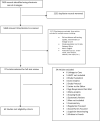HIV Self-Testing Uptake and Intervention Strategies Among Men in Sub-Saharan Africa: A Systematic Review
- PMID: 33681120
- PMCID: PMC7933016
- DOI: 10.3389/fpubh.2021.594298
HIV Self-Testing Uptake and Intervention Strategies Among Men in Sub-Saharan Africa: A Systematic Review
Abstract
Background: HIV testing is an essential gateway to HIV prevention and treatment services. However, HIV testing uptake remains low among men due to stigma, discrimination, and confidentiality concerns. HIV self-testing (HIVST) is an alternative HIV testing method that can address many of these barriers for men. We conducted a systematic review to examine HIVST uptake and intervention strategies among Men in Sub-Saharan Africa. Methods: We used a systematic approach to survey literature published from January 2010 to June 2020 using five electronic databases (PubMed-Medline, CINAHL Complete, PsychINFO, Google Scholar, and Web of Science) and a manual search. Studies were included if they were peer-reviewed, published in English, and examined HIVST willingness, uptake, and/or linkage to care and included men in Sub-Saharan Africa. Results: Sixty-three articles related to HIVST were reviewed. Of the included articles, 37 discussed HIVST uptake/acceptability and 24 discussed intervention strategies. Both oral swab and finger-prick methods had high acceptability with ease of access and availability of the test cited as important by men. Free HIVST kits were preferred by men. Secondary distribution of kits via peers, sexual partners, and female sex workers were successful. Conclusion: HIV self-testing is highly acceptable to men. More efforts are needed to develop policies to implement HIVST programs targeting men in Sub-Saharan Africa, including a focus on linkage to care in sub-Saharan Africa. Future interventions should directly target men independently in tandem with using peers and their romantic partners to promote self-testing among men in sub-Saharan Africa. HIVST kit distribution strategies should be combined with services that can offer confirmatory tests and counseling for men as well as linkage to care.
Keywords: HIV; Sub-Sahara Africa; men; self-testing; systematic (literature) review.
Copyright © 2021 Hamilton, Thompson, Choko, Hlongwa, Jolly, Korte and Conserve.
Conflict of interest statement
The authors declare that the research was conducted in the absence of any commercial or financial relationships that could be construed as a potential conflict of interest.
Figures
References
-
- World Health Organization . Global Health Observatory Data. (2019). Available online at: https://www.who.int/gho/hiv/en/ (accessed May 5, 2020).
-
- UNAIDS . Ending AIDS: Progress Towards the 90–90–90 Targets. (2017). Available online at: https://www.unaids.org/en/resources/documents/2017/20170720_Global_AIDS_... (accessed May 5, 2020).
-
- UNAIDS . Blind Spot: Reaching Out to Men and Boys. (2017). Available online at: https://www.unaids.org/sites/default/files/media_asset/blind_spot_en.pdf (accessed May 5, 2020).
Publication types
MeSH terms
Grants and funding
LinkOut - more resources
Full Text Sources
Other Literature Sources
Medical


